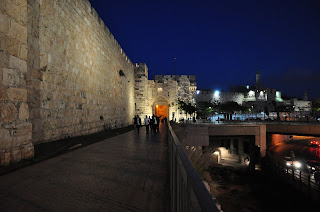May 15, 2018
On May 15, 1948, the British
Mandate ended a day after Israel was declared a nation. On May 15, the Arab nations attacked the new
Jewish State—with the combined forces including Syria, Jordan, Egypt, and
forces from Iraq. However, in a
surprising turn of events Israel was victorious.
May 15 is also the final day of the
Palestinian “Great March of Return.” This will be the final day of the 2018
Israeli-Gaza boarder protests that have been held every Friday since March 30,
which was Land Day on which Arab citizens of Israel and Palestinians
commemorate that day in 1976 when Israel announced its plan to expropriate land
from Arabs in Israel.
Today I visited the Ophel
Archaeological Park also known as the Davidson Center. This archaeological site contains ancient
streets, walkways, ruins of various structures, mikvehs (ritual baths), stairs,
and the remains of “Robinson’s Arch.”
Located on the Ophel Hill on the south side of the Temple Mount/Haram
al-Sharif, the site contains evidence from both the First Temple Period and the
Second Temple Period.
As you first enter the archaeological
site, there is a visual aid on the wall that shows an illustration of the many
peoples, nations, and tongues that have inhabited and/or ruled Jerusalem since
ancient times. There are thirteen in all.
1. Canaanite
2. Israeli
3. Babylonian
4. Persian
5. Hellenistic
6. Roman
7. Byzantine
8. Early
Muslim
9. Crusader
11. Ottoman
12. British
13. State
of Israel
On the south side of the mount,
there are remains of an ancient street and steps leading up to the mount. Nearby are a number of mikvehs (ritual baths)
that were used for purification before entering the sacred area.
Near the south west corner of the
Temple Mount/Haram al-Sharif is evidence from the Second Temple Period: 1) piles of huge stones near the wall; 2) major indentions in a street below the mount where
stones are thought to have fallen from above during the Roman destruction of
the temple; 3) among a heap of stones was a corner section that was engraved as
the “place
of trumpeting” that is thought to have been where the trumpet was blown
each Sabbath on the south west corner of the Temple Mount; 4) a stone under
Robinson’s arch with Hebrew text engraved into the stone based on Isa 66:14 dated
around 363 CE.
 |
| Damage of Herodian Street from Falling Stones off of Mount |
 |
| Pile of Stones near South West Corner of Mount |
 |
| Close up of Stones |
 |
| Section from South West Corner of Mount |
 |
| Another View of Section from South West Corner of Mount |
 |
| Replica of Hebrew Text "to the place of trumpeting to...." (original 1st Century CE) |
 |
| Hebrew Text from 4th Century CE (Isa 66:14) in Stone near South West Corner of Mount |




















































